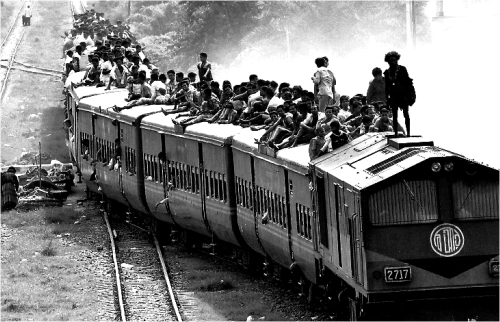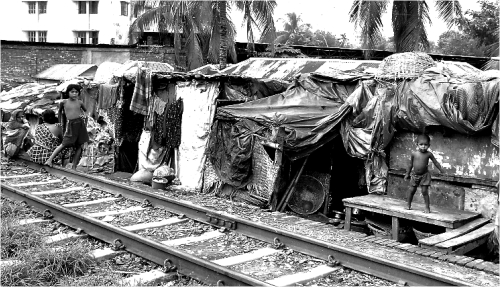 |
|
 |
|
 |
|
 |
|
Low cost housing
An effort to stop migration to cities
Md. Asadullah Khan
Nature is a messy place. It's always changing, often inhospitable and frequently excessive. For buildings and homes, we crave stability, consistency and moderation: in a word, shelter. So buildings and houses that we build should be in tune with their environment. Each dwelling, it seems, must have its own environment, with its temperature, airflow and water along with the stability to withstand the impact of flood water and fury of storm.
The idea if our homes could adjust to ever changing environment, as humans do, has now caught the imagination of environmental architects and engineers. People take off or put on clothes according to weather or their activity: why shouldn't their homes? Australian architect Glen Murcutt has successfully designed such homes in Sydney, Australia after studying the prevailing breezes, the water drainage and the flora and fauna of proposed building spots.
But the overriding fact is: over the last two decades the country has experienced phenomenal urban growth. With such rapid growth compounded by high concentration of population, Dhaka city has become an epitome of urban squalor, poverty and environmental abyss. Despite everyday trauma, exhaustion and rigor, people are helplessly attracted to the city; for it seems to have work, livelihood and even prosperity on offer but no safe , affordable and cost effective housing facilities. .During the last one decade the rapid influx of people at roughly 200,000 per year, the capital city has become a human sea that moves in massive tidal surges. Every inch of available space has been gobbled up for housing legally or illegally. . This has resulted in proliferation of slums occupying larger land space with consequent rise in pollution, waste and menacing sewage accumulation problem in the city areas. The need of the hour is to undertake housing construction in the countryside that is affordable, stable and that can withstand any type of disaster
In analyzing the housing practice in Bangladesh, it has been found that majority of the houses in the wind hazard or cyclone or flood- prone zones of the country fall under the category of non-engineered structures. All these traditional self-built housing for the poor classes of people mostly with thatched roofs are not covered by any code. They exhibit little or no resistance to violent winds. Collapse of this category of houses are responsible for such colossal loss of lives that we witnessed during cyclones and floods in the preceding years.
The peculiar situation of Bangladesh has made it vulnerable to natural hazards like cyclones, floods etc. which sometimes kill thousands of people and destroy properties on a massive scale. In an effort to mitigate the problem, experts in the country have devised a low-cost, better and safer housing for the rural poor.
In the choice of materials used in the low-cost housing, bamboo features most prominently, because it is the cheapest, abundantly available and most easily transportable material. Houses made of bamboo can be expanded easily when more money is available later and as such it is the choice of those on the lowest income group. Undoubtedly true, bamboo price in recent times has shot up and consequently the poorest people can afford the thinnest bamboo which may last for only one or two years. Poor quality bamboo framing is liable to be associated with walls made of bamboo-mat or jute stick panels which not only have poor durability but limited protection against monsoon rains. Bamboo has other shortcomings: it is vulnerable to insect attack and offers poor resistance to rotting
The proposed improvements in frame suggested by J.Lewis of
Datum International, UK and M.P Chisholm of CPM Design, U.K call for the treatment of bamboo against rot under the ground, better anchoring of poles into the ground, inclusion of cross-bracing and substituting galvanized wire binding for jute rope Dr. Hodgson of the university of Exeter in his recent work has developed some strengthening techniques that can be incorporated into a kucha house for an increase in cost that will not go beyond 8 per cent. As an experiment they have found that an expensive “char-chala”(hipped) CGI(corrugated galvanized iron) roof to be cheaper and may be lasting for over 25 years since it is more or less maintenance free.
Dr. Jamilur Reza Chawdhury, presently Vice-chancellor of BRAC University working as team leader of a research group while he was a professor in the Civil Engg. Deptt. at BUET developed as far back in 1979 a process using kerosene and asphalt in the ratio I:1 with mud. The expenditure involved in such construction was affordable by the poorest section of the country. With 750 gms. of the components used per sq. metre in the suggested construction, the cost rose up to Tk.28.00 per 100 sq.ft. which the poorest section of the community can easily afford.The experimental structure proved to be durable against natural hazards. It has been revealed from Dr. J.R Chowdhury's studies that the country has at present a shortfall of 3.5 million rural housing units and the country's population which is likely to reach 170 million at the modest count by 2020 out of which 110 million would be spread in the rural areas, the shortfall would be more acute. It was further learnt from Dr. Chowdhury's research team's findings that most houses in rural areas did not last over 10 years even without any natural hazards and the longevity of these houses could be raised up to 20 years with a little cost and extra additional materials as mentioned earlier. In an effort to make the mud walls more resistant to flood water, the builders might use polythene with straw along with an asphalt and kerosene coat. With impediments still blocking the dissemination of these indigenous technologies, the concerned agencies in the government must take effective measures in motivating people to follow these technologies taking into consideration the durability and affordability such dwellings promise. These findings further assert that in a bid to construct houses in the coastal areas where about 20 million people live constantly exposed to such natural calamities like cyclonic storms and tidal surges, houses could be built on concrete columns. Structures in these areas should be sited with trees so as to protect each other. Clustering achieves a degree of mutual protection that linear layouts do not. Frame could be improved with inclusion of cross-bracings. Frame members that are normally lashed with jute rope could be substituted with galvanized wires and nails and openings can be improved by placing door in the center of the wall and placing a small window opening in the rear wall. Roof system can be improved by increasing the pitch of the roofs between 30 to 40 degrees, tying down the thatch and arranging improved fixing for CGI sheet. Because of abysmal neglect and apathy in undertaking the improved type of construction in the rural areas , 75% of the houses are still kutcha houses that are destroyed by natural disasters like floods, cyclones and rainstorms. .After one has seen the poor plight of these battered people living in card board and shanties and thatched houses extremely vulnerable to even the most mild hazards, one develops the impression that the emphasis that was attached to rural housing through providing better access to land, finance, cheap affordable and durable materials following the Grameen Bank Model during the five year housing plan (1997-2002) was hardly attended to.
The government policy endorses soft loans for housing to the poor and creation of special fund to this end. The government policy further envisages construction of low-cost houses in coastal areas that will be constructed by local bodies with funding from the government. Regrettably, all these excellent policies has till now remained a grand illusion. It is worth mentioning here that a design for rural housing developed by Grameen Bank after the devastating flood in 1988 could still be followed with some modifications as suggested by Dr. J.R. Chowdhury's research team.The “Four Pillar Technology” that the Grameen Bank introduced in their “basic housing programme” could prove to be safer, durable and resistant to floods and heavy winds.
With little maintenance cost and fit for all weather, the structure can be shifted from one place to another during flood and other disasters. The structural components comprise four reinforced concrete pillars on brick foundation at the corners of the house and six intermediary bamboo posts with bamboo tie beams, wooden rafters and purlins supporting corrugated iron roofing sheets. Grameen Bank introduced a loan scheme of Tk.12,000.00 which includes the cost of 4 nos. R.C.C pillars (cost Tk. 1520.00 and a set of sanitary latrine components (cost Tk. 1000.00) to be supplied by the bank.
Shockingly , Bangladesh's rural areas have suffered at the hands of the policy makers. Resource allocation for rural housing, infrastructure, roads, power supply, and agro-based industries, over the years, has shown a downward trend. The future seems bleak as more and more people hit by desperate poverty situation and appalling lack of amenities flee from the country side to cities already bursting at the seams. Slums and squatters population have been increasing at more than double the general growth of urban population. .It is not only the absence of amenities but also the unclean way of life and total disregard of civic obligation that make these slums extremely filthy. Speaking about Dhaka city, there is nothing that we call urban discipline present here. Of late norms of organised civic life have been violated with impunity. To arrest this menace and halt exodus of people from the rural areas that have always generated wealth for the country.
Photos: AFP
..........................................................
The author is contributor of The Daily Star .

